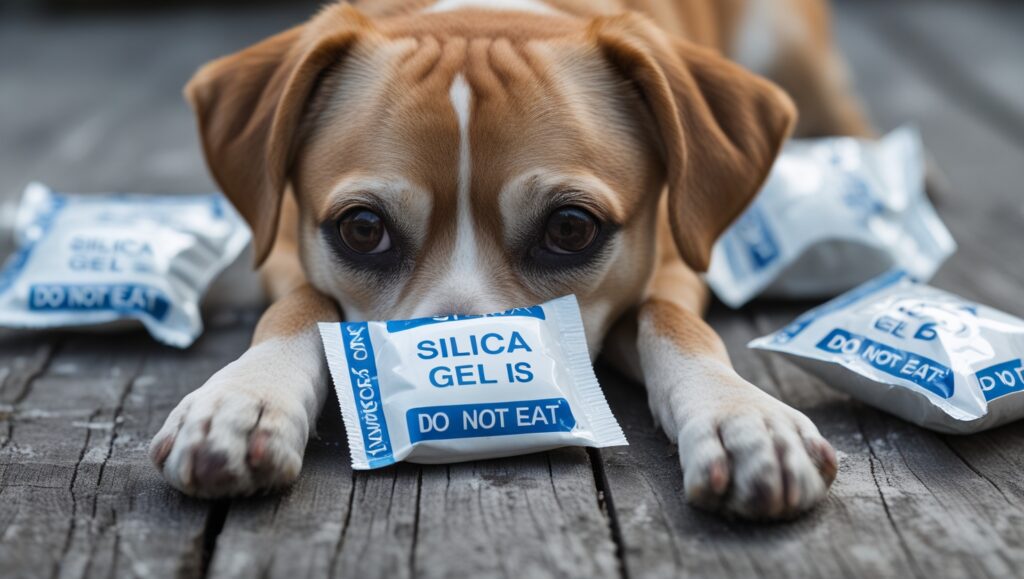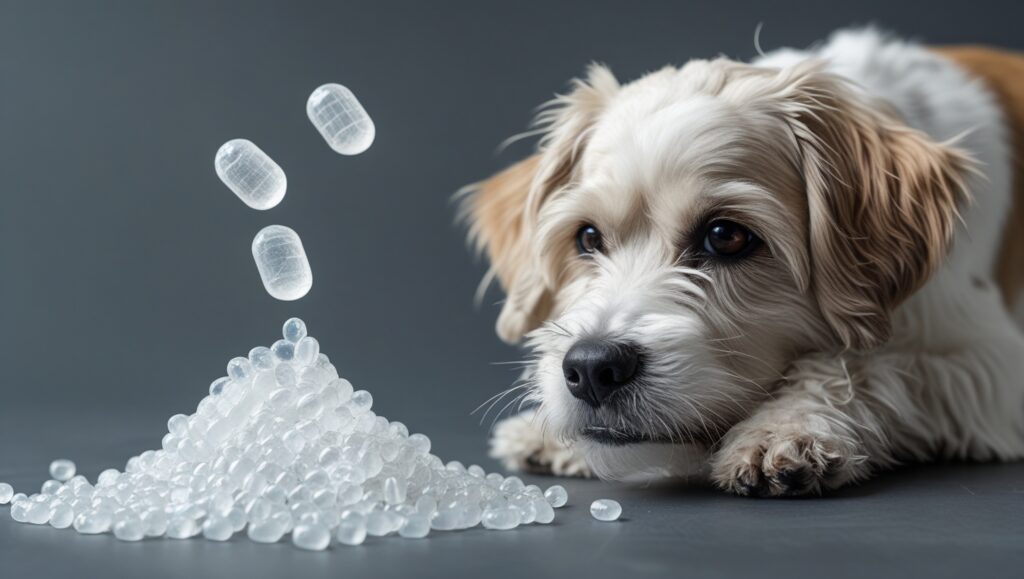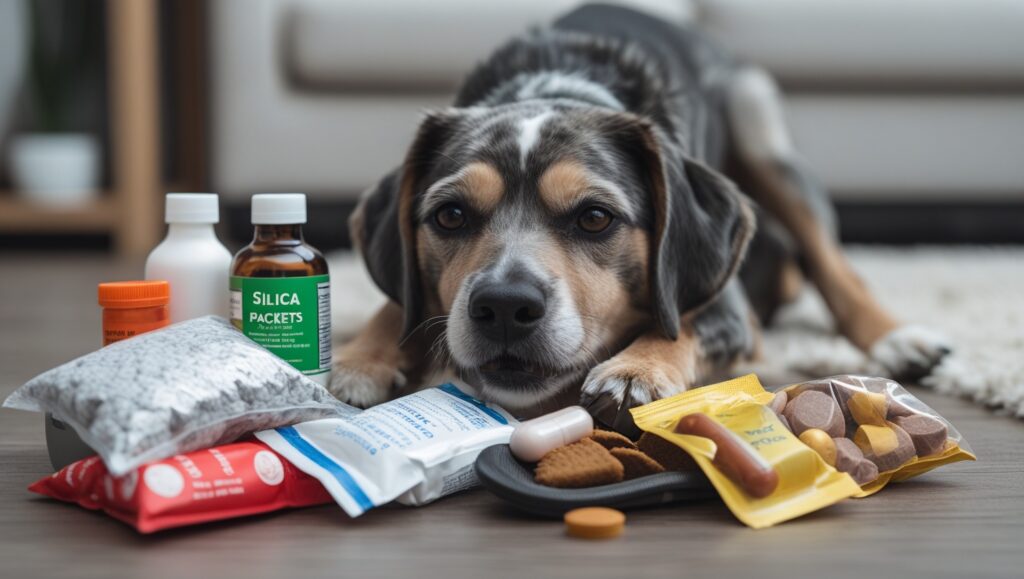It is scary when you realize your dog ate a silica packet. Those small, white sachets marked as Do Not Eat seem very hazardous; however, are they poisonous to dogs? Relax, because if you happen to be handling this situation now, do not panic. This post will tell you precisely what silica gel is, what symptoms to be on the lookout for, and what you must do to help keep your dog safe.
Table of Contents

What is Silica Gel? Why do we use it?
Silica gel is an example of a desiccant drying agent that is often applied in the packaging of products to avoid such outcomes as the consequences of moisture. These small packets were probably in one of your shoe boxes or bottles of vitamins, or snack bags. They are usually stated in “Do Not Eat” terms, but what occurs when that silica gel packet is consumed by your dog?
Silica Gel—Are Dogs Toxic to It?
Silica gel does not harm dogs in most instances. The drug, in its turn, is chemically neutral; that is, it does not interact with the body’s systems. But what is usually the hidden menace?

- Suffocation (particularly on small dogs or puppies).
- When the packet does not go through the digestive tract, it produces intestinal obstruction.
- Silica gels contain potentially toxic substances like cobalt chloride, and they are color-indicating.
Therefore, although regular white silica gel, as a rule, is non-toxic, the cases of ingesting it should not be disregarded.
Signs to Look Out For When Your Dog Eats a Silica Packet
Although the packet may not be poisonous in itself, it may end up irritating the gastrointestinal system or lead to other complications. The following are the symptoms to be on guard:
- Vomiting
- Diarrhea
- Drooling
- Anorexia
- Lethargy
- Choking manifestations/gagging
- Pain, febrile or urticaria in the belly, Brum Turmel.
There can be a mechanical blockage if your dog ate the packet as a whole. In such cases, symptoms may manifest 6-24 hours later.
What Should be Immediately Done?
1. Stay Calm
Panicking is not the way to go, not for you or your dog. In the greater part of cases, dogs encounter silica gel packets without any troublesome effects.
2. Look In the Packet
It may be possible to tell whether the silica packet was a typical clear/white silica packet or a color-indicating silica packet (usually blue or pink-colored beads). In case it is the latter, it may have toxic elements such as cobalt chloride, and it is more harmful.
3. Say your Veterinarian
You may want to call your vet even if your dog appears to be okay and tell him/her what happened. Give such details as
- The size and breed of dogs.
- Time of administration (roughly).
- Type and size of packets.
- Be it chewed or swallowed whole.
4. Do not try to force vomit on Your Own
Other dog owners are guilty of their transgressions when they attempt to make their dogs vomit by employing hydrogen peroxide. This must be done only on professional advice. It can even bring harm rather than profit.
5. Watch Carefully Over the Next 24-48 Hours
Examine the stools of your dog to know whether the packet has passed out naturally. Monitor their energy and appetite.
How to Know When it is an Emergency?
If you observe any of the following, you must bring your dog to the emergency vet right away:

- Continuous vomiting
- No defecations
- Stool or Vomit with blood.
- Difficulty breathing
- Distended or hard abdomen.
- Extreme lethargy
They might be indicators of obstruction or poison and must receive prompt treatment.
Are Silica Gel Packets Lethal to Dogs?
There are a few fatal cases, and these would normally include either:
- Yet it is small dogs or puppies who are at greatest risk of choking.
- Consumer ingestion of quantities of or poisonous forms of silica gel
- The health problems that cause the dog to be sensitive, Underlying problems that predispose the dog to being more sensitive
- Most of the time, when your dog swallows a silica packet, they will pass, and in some cases, it will cause mild digestive distress.
Preventing Future Incidents: How
Dogs are curious, and their sense of smell gets them to consume items they ought not to. The following are instructions on preventing accidents in the future:

- Silica packets are to be disposed of as soon as you unpack the products.
- Do not leave packages, bottles of medication, and snack bags where your dog can get access to them.
- Shoes, food, and supplements should be kept in a pet-safe storage bin.
- Train your dog with such phrases as Leave it, or Drop it.
Conclusion
Without panicking, analyze the action taken by your dog who ate a silica packet. No one has won the lottery because most silica gel packets are not harmful and will not cause significant complications, refuting the point of the previous album. Nevertheless, you may reach your vet, monitor such symptoms, and be swift in case of certain complications. Your fluff ball will be fine with the appropriate amount of care and attention.
What will be the case when my dog ingests a silica gel packet?
Your dog will be alright in most situations. Silica gel is harmless, yet it may result in nausea or bowel obstruction. Your doctor should give you advice.
How fast does a silica packet digest in dogs?
Closely, 24-48 hours. Keep an eye on the stool and symptoms of your dog. In case you do not observe the packet and the symptoms seem to deteriorate, go to a vet.
Does the colored silica gel become any more dangerous than the clear silica gel?
Possibly yes, colored silica gels may contain chemicals like cobalt chloride, which is poisonous. Also, should your dog swallows a colored packet, then get some veterinary assistance.




Pingback: 5 Things to Know About a Tick Scab on a Dog: Causes & Care Tips